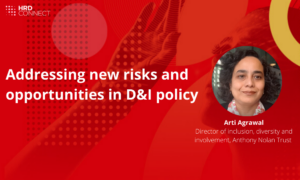Are we doing enough for trans employees?
- 4 Min Read
Are we doing enough for trans employees? With insights from Kate Williams, Head of Private Sector Memberships, Stonewall, HRD Connect delves into the conversation around transgender inclusion in the workplace.
- Author: Louron Pratt
- Date published: Dec 9, 2019
- Categories

Studies by the National Centre for Transgender Equality found that more than one in four transgender people have lost jobs due to bias. What’s more, three-fourths have experienced some form of workplace discrimination. Kate Williams believes that transgender employees in the workplace aren’t a discovery, they’ve just always been invisible until recent times.
“Trans people have always existed, but recently they’ve become more visible. If you’ve read a newspaper, been online or watched TV in the past few months, you’ve probably seen some shocking headlines about trans people. These stories have a damaging impact. They can affect people you work with every day,” said Kate Williams, Head of Private Sector Memberships, Stonewall.
“Businesses can be at the forefront of driving equality in society, creating spaces where customers, employees and the wider LGBT community can be accepted. Trans staff and customers face distinct challenges from non-trans LGB employees, which is why we started measuring employers on what they’re doing for trans equality through our annual Workplace Equality Index.”
“We know from our research that one in eight trans employees (12%) have been physically attacked by a colleague or customer in the past year, while half of the trans people (51%) hide who they are for fear of discrimination at work. These figures paint a troubling picture of life at work for many trans people and it’s a situation none of us should accept.”
In addition to Stonewalls research, the Government Equalities Office revealed that at least two in five respondents had experienced an incident because they were LGBT, such as verbal harassment or physical violence in the 12 months preceding the survey. However, more than nine in ten of the most serious incidents went unreported, often because respondents thought ‘it happens all the time’.
“Despite the progress we have made as a country, we should not be blind to the fact that LGBT people continue to face barriers to full participation in public life. We want to build a country that works for everyone, and that means tackling these burning injustices,” said Penny Mordaunt, Minister, Women and Equalities, commenting on their latest findings.
So, what can workforces do to improve transgender inclusion, and what impact can this have on the LGBTQ+ community? Communication and transparency are pivotal if business leaders are to instil this inclusive culture within their organisations.
“Having a workplace that accepts everyone isn’t just the right thing to do, it also makes good business sense. When staff feel comfortable and happy, they will perform much better than if they’re having to hide who they are,” continued Kate.
No matter where a business is starting from in creating an effective inclusion program, Kate believes that there will always be ways to improve trans inclusion. Creating an environment where everyone feels comfortable in their skin is significantly more effective than a simple tick-box exercise, it needs to be a process that starts with continuous actions.
“There are a host of trans-specific measures employers can adopt to improve the workplace for trans employees and consumers. One easy way is demonstrating support on events such as Trans Day of Visibility and Trans Day of Remembrance,” continued Kate.
“Companies can also update systems to offer gender-neutral pronouns like Mx on titles and provide gender-neutral facilities. As part of basic training for staff, businesses can outline a zero-tolerance policy for transphobic bullying, discrimination and harassment, as well as developing policies to support employees who are transitioning, including information on confidentiality, dress codes and facilities.”
“The best way to make the changes that will have the most impact is to ask those directly affected. Listen to the needs of trans employees and address the challenges they raise. This means creating safe spaces for employees to come together, discuss issues and offer potential solutions. Don’t assume that if you don’t know of any trans people within your organisation that they don’t exist.”
Organisations across many sectors have already made great strides towards building more inclusive workspaces for trans staff. Kate believes is crucial for businesses to take some time to think about how business leaders can show support for trans equality and take the lead in embedding trans inclusion into businesses year-round. This is a vital step towards improving life for trans people.
Once this is made a priority for businesses, it can unlock a plethora of benefits for both employees and business leaders, helping both groups to create an effective and inclusive culture where everyone can bring their whole selves to work.









